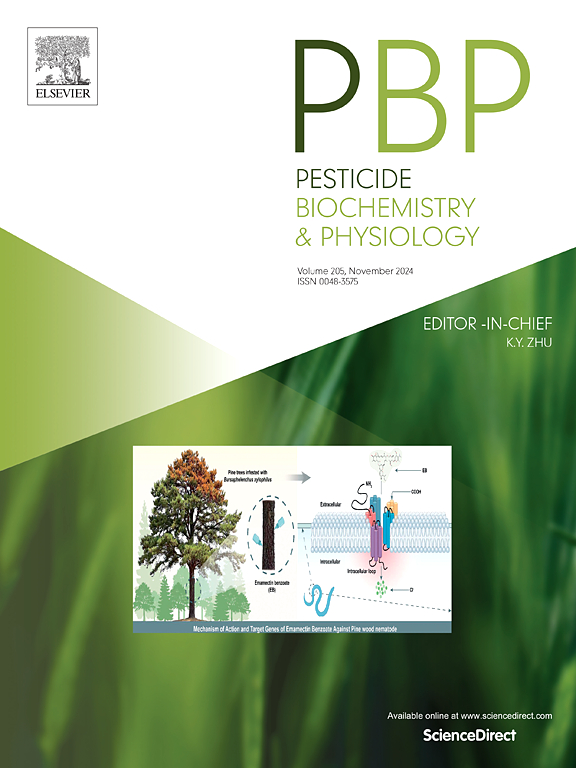细胞色素p450介导的洋葱蓟马、烟草蓟马对敌百虫的抗性
IF 4.2
1区 农林科学
Q2 BIOCHEMISTRY & MOLECULAR BIOLOGY
引用次数: 0
摘要
洋葱蓟马,烟叶蓟马,已经对许多杀虫剂产生了抗性,在过去的十年里,抗性种群在日本广泛传播。细胞色素P450 (CYP)家族是一种广泛保守的解毒酶,可代谢杀虫剂和植物化学物质等外源物,被认为在烟粉虱抗性的发展中发挥重要作用。然而,参与烟粉虱杀虫剂抗性的CYPs尚不清楚。为了全面鉴定烟草粉虱的CYPs,构建了烟草粉虱(ANO菌株)的基因组序列,预测了18965个基因(蛋白质编码)。通过人工筛选,我们在预测基因集中鉴定出127个CYP基因,其中38个CYP基因属于CYP3家族,包括CYP6家族的基因,CYP6家族是参与许多害虫对新烟碱抗性的最重要的CYP家族之一。为鉴定烟草粉虱对新烟碱类杀虫剂呋喃(dinotefuran)产生抗性的CYPs,对耐药菌株和敏感菌株进行了RNA测序。结果显示,TtCYP3652A1在抗性菌株中显著上调,该基因属于CYP3家族中蓟马特异性CYP3652A亚家族。利用昆虫细胞对TtCYP3652A1和5个高表达CYP6基因进行体外CYP代谢测定。只有TtCYP3652A1显著代谢呋虫胺,被认为与呋虫胺解毒有关。由于新烟碱类药物已知靶位基因中未发现氨基酸突变,因此认为TtCYP3652A1可能是新烟碱类药物耐药的主要因素。本文章由计算机程序翻译,如有差异,请以英文原文为准。

Cythochrome P450-mediated dinotefuran resistance in onion thrips, Thrips tabaci
Onion thrips, Thrips tabaci, have developed resistance to many insecticides, and over the last decade, resistant populations have spread widely across Japan. The cytochrome P450 (CYP) family, a widely conserved detoxification enzyme that metabolizes xenobiotics such as insecticides and phytochemicals, is believed to play important roles in the development of resistance in T. tabaci. However, CYPs involved in insecticide resistance in T. tabaci remain unclear. To comprehensively identify CYPs in T. tabaci, the genome sequences of the thelytokous T. tabaci (ANO strain) were constructed, and 18,965 genes (protein coding) were predicted. We identified 127 CYP genes in the predicted gene set by manual curation, and 38 of these CYP genes belonged to the CYP3 clan, including genes from the CYP6 family, which is one of the most important CYP families involved in resistance to neonicotinoids in many insect pests. To identify the CYPs involved in resistance to dinotefuran, which is one of the neonicotinoids used to control T. tabaci, RNA sequencing of dinotefuran-resistant and dinotefuran-susceptible strains was performed. Results revealed that, TtCYP3652A1, which belongs to the thrips-specific CYP3652A subfamily in the CYP3 clan, was significantly upregulated in the resistant strain. In vitro CYP metabolism assays using insect cells were conducted for TtCYP3652A1 and five highly expressed CYP6 genes. Only TtCYP3652A1 significantly metabolized dinotefuran, which is considered to contribute to detoxification of dinotefuran. As no amino acid mutations were identified in the known target-site genes of neonicotinoids, TtCYP3652A1 was considered to be the main factor involved in the resistance to dinotefuran.
求助全文
通过发布文献求助,成功后即可免费获取论文全文。
去求助
来源期刊
CiteScore
7.00
自引率
8.50%
发文量
238
审稿时长
4.2 months
期刊介绍:
Pesticide Biochemistry and Physiology publishes original scientific articles pertaining to the mode of action of plant protection agents such as insecticides, fungicides, herbicides, and similar compounds, including nonlethal pest control agents, biosynthesis of pheromones, hormones, and plant resistance agents. Manuscripts may include a biochemical, physiological, or molecular study for an understanding of comparative toxicology or selective toxicity of both target and nontarget organisms. Particular interest will be given to studies on the molecular biology of pest control, toxicology, and pesticide resistance.
Research Areas Emphasized Include the Biochemistry and Physiology of:
• Comparative toxicity
• Mode of action
• Pathophysiology
• Plant growth regulators
• Resistance
• Other effects of pesticides on both parasites and hosts.

 求助内容:
求助内容: 应助结果提醒方式:
应助结果提醒方式:


